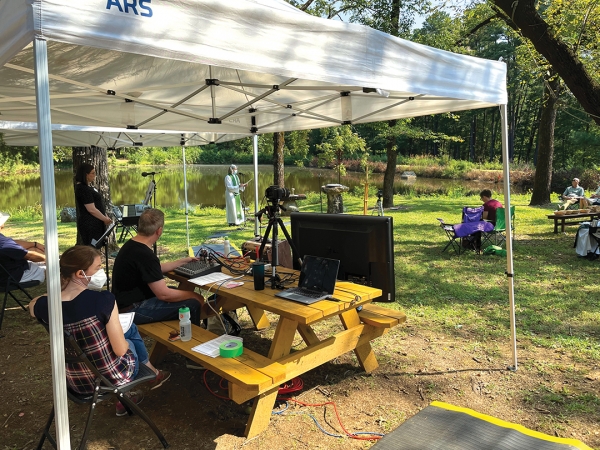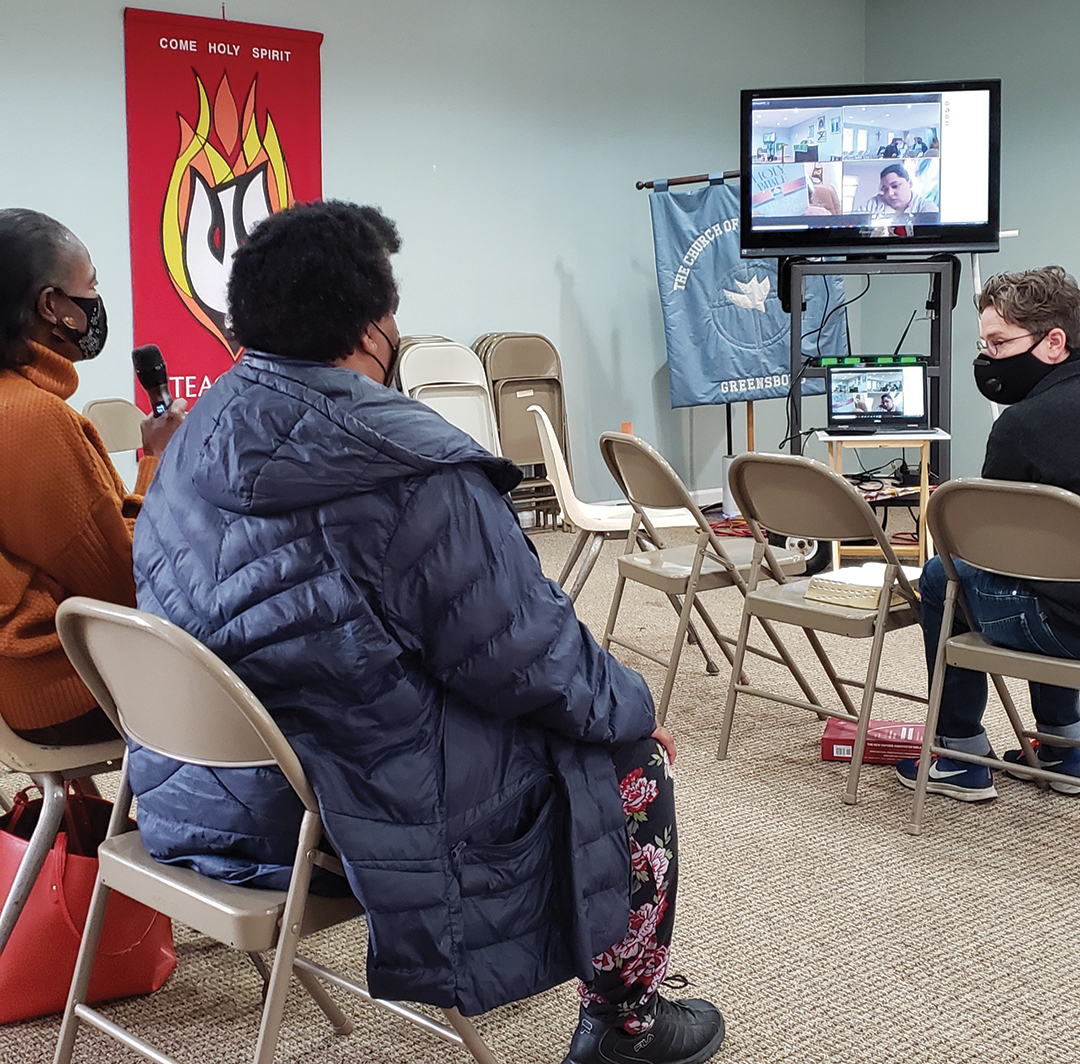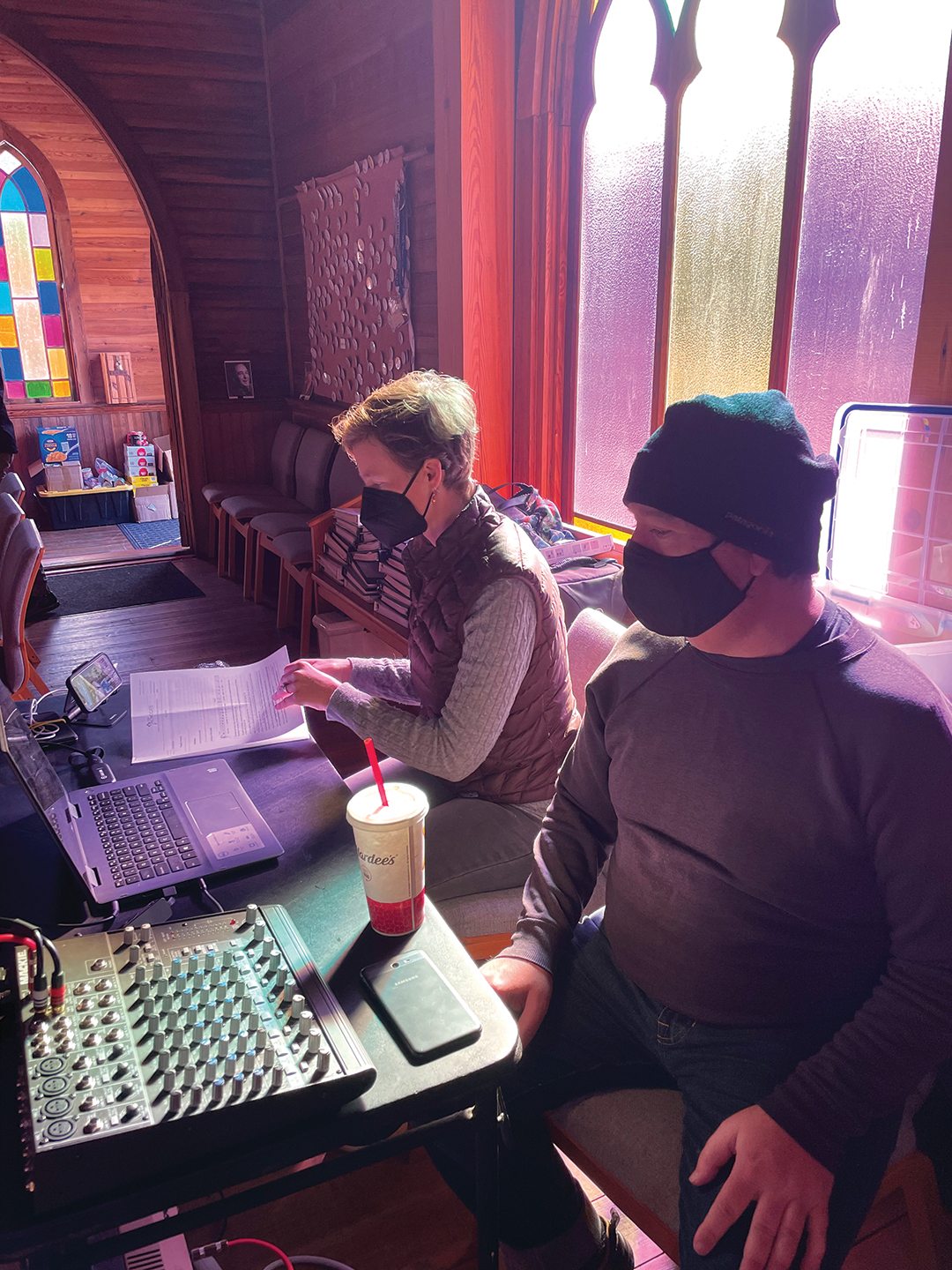Disciple: Blending Communities

Exploring the possibilities of hybrid worship
As the old saying goes, every cloud has a silver lining, even the dark cloud of the pandemic under which we’ve all been living for the last 20 months. Along with the challenges the pandemic brought, gifts emerged. As our lives shifted and new patterns and processes became possible, many found time to explore new hobbies, embark on healthier habits and reimagine their work/life balance.
New ways of doing things were not limited to individuals. No community was unaffected, and that certainly included worship communities. Physical doors were forced to close, creating room for metaphorical doors to open. Congregations that hadn’t yet explored a social media presence found themselves livestreaming services and offering online Bible studies, while those that had experimented with technology prior to the pandemic took it to the next level.
The anecdotal results of all of these efforts surprised some and were a delight to others. Churches discovered new audiences and welcomed back parishioners who were no longer able to attend services because of physical limitations or relocation. Families that could not worship together because of geographical distance could worship together once again. New parishioners that have yet to enter physical church spaces found new church homes because they discovered them online.
[Image: A monitor sitting on the picnic table in the technology tent allows members of the in-person congregation to greet those worshiping online. Photo by Grace Camblos]
A natural wish throughout the pandemic has been for things to return to “normal” when the pandemic is done. But as we’re learning with each passing month, the pandemic is unlikely to have a definitive end point but rather will be a part of our lives for some time to come. Too, changes made necessary by the pandemic have become such a part of our lives, with so many gains and benefits recognized, that discarding those gains and gifts to return to the way things were before can feel like steps backward.
We are entering a “new normal,” and that’s okay. Technology, especially, is here to stay. As we take our tentative steps forward to re-engage with the world and each other, churches that have welcomed new and returning members during their time online are loath to let them go. But how to blend those who are returning to church in person with those who choose to remain online? That is an increasingly frequent and energetic topic of conversation.
So let’s talk about the prospects of building a hybrid worship community. This is not a definitive how-to but the start of a conversation because we’re all still exploring ways to do this. This is not a guide on equipment; the scope of what’s available, possible and needed is simply too broad. And it’s not a discussion about how to incorporate the sacraments of worship into the hybrid space—that is a topic still very much being considered and discussed at the highest levels of the Church.
What we will discuss here are some of the considerations and practices shared in conversation. The hope is it will help those pondering how to blend in-person and online communities find some starting points and guideposts to discover what works for them.
LIVESTREAMING VS. HYBRID
First, let’s define what’s meant when discussing hybrid communities. “Livestreaming” and “hybrid” are often used interchangeably, but, in reality, they are very different things.
Think of livestreaming as a television broadcast. Though those watching may comment or respond, it’s really a one-way broadcast that takes place in one location and is viewed in another. The emphasis is primarily on the in-person site, while allowing those off-site to view the proceedings.
Hybrid worship is more of a two-way approach. It is meant to be inclusive, inviting participation from those both in person and online. In a hybrid situation, those in person and those online are equally important, and all are invited to take part and connect as a single community.
CREATE IT TOGETHER
If the goal is to create a truly hybrid community, it makes sense to create it as a community. This is a new world, and no one person has all the answers. There is no right or wrong way of doing it. It is a time of trial and error, of experimentation and learning one step at a time what works for you as a community. Just as every congregation had its rhythms and identity when in person only, so will a hybrid community find the same. It doesn’t happen overnight or all at once, and it takes every person involved to find what works.
Start with conversation. Invite as many voices into the conversation as possible, including both those who embrace the possibilities that come with a hybrid community and those least comfortable with the idea. Then, start at the beginning.
START WITH THE WHY

Before you start trying to figure out the “how” of building a hybrid community, start with the “why” you are doing it in the first place. Take some time to think about what drew you together and connected you in the days before the pandemic. Find one thing that matters to your congregation, that really creates a feeling of community. You may find if you can identify what you are trying to do and why you are doing it, answering the question of how to accomplish it becomes much easier. Such was the case with Holy Spirit, Greensboro.
“Holy Spirit was not a technological congregation,” said the Rev. Audra Abt, vicar of Holy Spirit. “It wasn’t part of our life together, so when we realized we’d need it during the pandemic, it quickly became overwhelming. So we took a step back and started with the question of what was important to us in the first place.”
[Image: A camera-equipped laptop and a monitor in the worship space allow both in-person and online parishioners to see each other during worship at Holy Spirit, Greensboro. Photo courtesy of Holy Spirit]
One aspect of their communal life that mattered quickly came to mind: prayers of the people. Even before the pandemic, the congregation dedicated extra time to prayers of the people as part of their regular practice, as it created a connection to each other and with those not in attendance in a way that meant a great deal to those offering the prayers. When it came time to move online, maintaining that connection and practice was a priority. In doing so, it gave the congregation a starting point in navigating what overwhelmed them before.
“We had to learn how to Zoom, how to broadcast,” said Abt. “But starting with the basic question of what was important to us let us step away from focusing on getting back to the physical space and instead spend time focusing on how we connected—or struggled to do so—and asking what we needed to learn, needed to do and needed to let go to make those connections possible.
“We focused on our values and who we are as a community—who we are and who we want to be. We realized it wasn’t about the livestream or technology itself, it was about being drawn together by Christ and continuing to love and serve each other, even if we had to find a different way to do it. And that helped—it helped us find a way forward, and it helped us realize that while ‘how’ we were doing it was different, the ‘what’ we were doing was exactly what we were doing all along.
“The new ways may feel different, but the principles behind the new ways are the same as they always were. The call to connect and care for one another and overcome the barriers of how we do that is not a new call.”
INVITE THE DEVICES IN
 In creating a hybrid community, the devices that make them possible have a potentially significant role to play. It is this prospect that can also be a source of great resistance. But before the prospect is discounted outright, consider what inviting devices into church life might make possible.
In creating a hybrid community, the devices that make them possible have a potentially significant role to play. It is this prospect that can also be a source of great resistance. But before the prospect is discounted outright, consider what inviting devices into church life might make possible.
It’s true that the start of a hybrid community may need only a camera to share what is happening in the physical space and a screen so those in the physical space can see and connect with those online. If this is where you start, consider adding a few extras to help connect all those in attendance. Mirror online what is happening in the physical space: if you have in-person ushers and greeters, appoint a person or two to serve in that capacity for online attendees. If you have lay readers participating in the service, invite both those in person and online to serve in that role. If you print and provide bulletins to those in the pews, ensure a digital version is available to and shared with those attending online. When the collection plate is passed, have a digital method by which those online can also make an offering. If congregational participation is encouraged, be sure to include the voices online. Find spaces for both in-person and online parishioners to participate in parts of the service in the same way. When Holy Spirit was discerning their own approach, they came up with the idea of passing the peace via sign language. It began as a way for everyone to be able to “speak” at once online, and it has become a beloved—and connecting—practice that continues as the congregation now worships as a hybrid community.
[Image: Dedicated volunteers run the hybrid worship service at the Advocate, Chapel Hill. Photo by Erica Fedor]
At Church of the Advocate, Chapel Hill, parishioners are encouraged to get up and walk to a Zoom station to greet those online. Having established connections on Zoom that worked well when they were online only, as they moved to an outdoor/online hybrid worship, before services or when it came time to pass the peace, those on-site got up and moved to the camera and Zoom station to wave directly and chat with those attending online.
“We’ve had to be a bit more intentional now that we’ve moved inside,” said Grace Camblos, dedicated parishioner and now-official tech steward for the Advocate. “We don’t have our screen inside, so instead we’ve set up multiple computers so folks can still say hello.”
If and when you’re ready to go deeper, consider inviting devices into your church life, as they can provide the individual points of connection that collectively help create a feeling of community. Devices don’t have to take over; start by creating specific spaces for them and define when they will be used. Texting before services as folks gather in both locations may be encouraged, or perhaps encourage parishioners to use devices to help pass the peace to online individuals or offer prayers during prayers of the people. If you’re using platforms like YouTube or Facebook Live, encourage those on-site to comment online during those times. The uses can be subtle but the impact powerful if it helps to overcome barriers and create true connections among those worshiping together.
SPACE FOR GRACE
No matter how you try it, remember as you begin building a hybrid community to give yourself space for grace. It’s unlikely you’ll get it exactly right on the first try. It’s very likely you’ll experience hiccups, ideas that sounded good and just didn’t work, resistance to change and all the other challenges that come with something new.
“It doesn’t have to be perfect,” said Camblos, “and when it’s not, it’s okay. We’re all real people, stuff happens and we’re going to love each other anyway. In person or online, it’s the people who show up that make church what it is.”
Camblos encourages ongoing conversation both to help congregations get started and refine things as they go. “You don’t have to reinvent the wheel,” she said. Speak with others undertaking their own hybrid experiments to share ideas and experiences, and stay in touch with your own community. “Ours isn’t perfect,” said Camblos. “We’re still working on it. We debrief every week to think about what worked and what didn’t, and we stay in close conversation with those in our community—both in person and online—to check in on how they’re experiencing worship, what works and what we might do better.”
We said it before, but it bears repeating—this is a new landscape for us all. We’re all in a place of exploration. What matters is that every step toward building a hybrid community is intentional and done with love and the desire to connect in a meaningful way. Technology is a tool, but it’s only a tool. It cannot create what really makes us a community: a feeling of connection, welcome, belonging and being seen. That is something only the people of a community can create and share, and if a genuine desire to do so is the why you are doing it, the how is sure to follow.
Christine McTaggart is the communications director for the Diocese of North Carolina.
